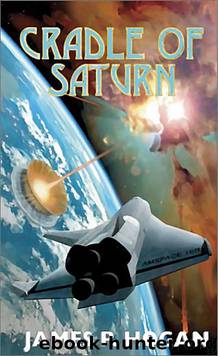Cradle of Saturn by James P. Hogan

Author:James P. Hogan [Hogan, James P.]
Format: epub, mobi
Tags: Science fiction, Adventure, General, Fiction, Science Fiction & Fantasy, Fiction - Science Fiction, Space Opera, Space colonies, Science Fiction - Adventure, Science Fiction - Space Opera, Science Fiction - High Tech, High Tech, Saturn (Planet)
ISBN: 9780671578664
Publisher: Baen Books
Published: 2010-01-21T15:55:18+00:00
27
The first matter, as opposed to accelerated charged particles, to begin arriving was in the form of molecular clouds and microscopic dust swept ahead of Athena by the solar wind, recorded by satellite-borne instruments and measuring stations on the lunar surface. On Earth, the effect was seen in spectacular sunsets worldwide, followed, as the grain size increased, by brilliant displays of burnup trails in the upper atmosphere. From California to Calcutta, people threw barbecue parties or just ate outside to relax in the cool while watching the shooting “stars” and electrical displays. Others took the warnings of meteorite showers more seriously by putting a fire extinguisher or two in the attics and making sure to park the car in the garage.
Not all reactions were that complacent, however. Astronomers around the world were comparing results and beginning to realize that something was amiss. While some were cautious and unsure what to make of the new factors affecting orbital calculations that had been claimed at the Washington conference, others were quick to take their fears to the media. Observational data were shared over the Web as a matter of routine, and there were thousands of amateurs and enthusiasts with the software to determine that what had been predicted wasn’t happening. Some were already connecting the rumors with visions of Athena being a repeat of Venus, and news stories appeared in Germany, Taiwan, and Australia asking if something was being covered up. Very soon it would be noticed that public and emergency services everywhere were shifting into higher gear, and then the stampede to get information would begin. In fact, more than a few news reporters, journalists, commentators, activists, and others who made a business of sensing things in the wind were already asking questions. President Hayer’s policy, in which he had asked the other world leaders’ cooperation, was still to avoid risking a premature panic by deferring an official statement until the scientific community could at least present a consensus as to the scale and extent of what should be expected.
The problem was that the stories Hayer was getting were contradictory. Hixson at Goddard, for example, was now giving figures less daunting than the ones he had supplied to Keene and had backpeddled to a position of saying that perhaps his initial fears had been exaggerated. Reports from the IAU’s Cambridge center, where Tyndam was based, were confusing and seemed to vary between Hixson-like hopes for things perhaps being not be so bad, to violent disagreement, depending whom one asked. This contrasted with the input from JPL, which was consistent and bad-worse, in fact, than the predictions that Keene had heard from Hixson to begin with. And in this, the JPL line agreed with the picture Keene was getting from the other sources that he was in contact with directly.
The Russians in particular were taking the Kronian probe measurements and revisions of the electrical properties of free space in the inner Solar System very seriously, and had calculated that Earth and Athena would come close enough for their magnetospheres to intersect.
Download
This site does not store any files on its server. We only index and link to content provided by other sites. Please contact the content providers to delete copyright contents if any and email us, we'll remove relevant links or contents immediately.
Sita - Warrior of Mithila (Book 2 of the Ram Chandra Series) by Amish(54744)
The Crystal Crypt by Dick Philip K(36814)
Cat's cradle by Kurt Vonnegut(15251)
Always and Forever, Lara Jean by Jenny Han(14845)
Ready Player One by Cline Ernest(14573)
The Last by Hanna Jameson(10190)
Year One by Nora Roberts(9741)
Persepolis Rising by James S. A. Corey(9284)
The remains of the day by Kazuo Ishiguro(8887)
Never let me go by Kazuo Ishiguro(8777)
Red Rising by Pierce Brown(8677)
Dark Space: The Second Trilogy (Books 4-6) (Dark Space Trilogies Book 2) by Jasper T. Scott(8142)
The handmaid's tale by Margaret Atwood(7705)
The Circle by Dave Eggers(7063)
Frank Herbert's Dune Saga Collection: Books 1 - 6 by Frank Herbert(6996)
The Testaments by Margaret Atwood(6832)
Legacy by Ellery Kane(6616)
Pandemic (The Extinction Files Book 1) by A.G. Riddle(6485)
Six Wakes by Mur Lafferty(6197)
